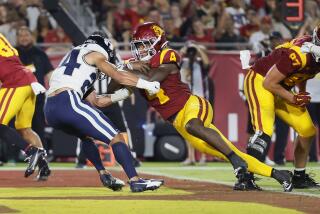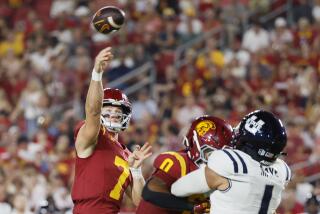Teams That Go Long Can Sometimes Bomb
- Share via
It seems as though the only thing that matters to sports fans anymore is the home run, and apparently the USC Trojans think the same way.
They spent most of Saturday night’s game against Oregon State trying to make the big play happen, glossing over the details (i.e., the rules of the game) to the point that their 40-20 victory wasn’t secure until they scored two touchdowns in the final 90 seconds. Try winning every week when your team is penalized 11 times for 102 yards.
The theme of the night was the long ball. They even showed a replay of Mark McGwire’s 62nd home run on Diamond Vision.
Of course, it’s hard not to think about a big play when R. Jay Soward wears your uniform. The man is a highlight waiting to happen.
The statistic that USC likes to put out, and all of us in the media eat up, is that Soward averages a touchdown every 5.5 times he touches the ball.
In the wake of Saturday night’s game it might be time to get a little picky. What exactly constitutes a touch? Soward made a couple of fair catches on punts. Do those count as touches? On one he called a fair catch and the play was negated by a penalty on Oregon State. Now that shouldn’t count as a touch. When the down was played over, Soward fumbled the punt, picked it up, ran four yards and fumbled again. Does that count as two touches?
USC Coach Paul Hackett doesn’t want Soward to have all the fun to himself. Just about everyone had their chance for glory, as Hackett made his plan of attack clear early on.
Every time the Trojans set foot in Oregon State territory, they started thinking end zone.
On the fourth play of the game, Hackett had Mike Van Raaphorst throw long to Larry Parker on second and eight from the Oregon State 47 for a touchdown. On the next possession, Van Raaphorst tried to go deep to Soward on third and six from the Oregon State 48. It was incomplete.
When it comes to play-calling, Hackett will never be accused of being too conservative. On a third and one, from the Oregon State 47, a run situation with a run formation (only one receiver), Van Raaphorst threw long to Soward. Soward managed to escape two defenders and got his hands on the ball in the end zone but couldn’t hold on. (Should that count as a touch?)
The constant deep balls were attention grabbing, but they never let the offense develop a flow. The steady stream of short drops, slant patterns and quick outs that are supposed to be a staple of the West Coast offense were nowhere to be found.
Carson Palmer was watching all this from the sideline, and the freshman couldn’t wait to get in on the action. One play after he took his turn at quarterback in the second quarter, he dropped back from his own 48 and tried to go deep to Soward on the right side. In his eagerness, Palmer committed a double no-no: underthrowing the ball into double coverage. He was lucky he didn’t have to pay for it, because Oregon State defensive back Terrence Carroll dropped what should have been an easy interception.
Even four-legged creatures caught the big-play fever. In the second quarter a stray dog ran the length of the field--it was credited with a 100-yard run on the official play-by-play summary--then made like Rafer Johnson in the ’84 Olympic opening ceremonies and ran up the steps of the peristyle end before heading out of the Coliseum.
Ironically, it was the unheralded guys and the simple stuff that made the difference for USC in the first half.
Usually, any glory for the return team is reserved for the deep men. But it was the grunt special teamers who produced a touchdown this night. A walk-on, Danny Bravo, blocked a punt in the second quarter and Rashard Cook hustled to catch up to the ball before it bounced out of the end zone for USC’s second touchdown.
And one of USC’s longest plays from scrimmage came on a basic running play that Chad Morton’s speed turned into a 42-yard gain. That led to a field goal and 17-7 lead.
But the Trojans gave the three points back. With all of the penalties the Trojans keep racking up (eight more in the first half alone Saturday), some have to come back to punish them.
In the second quarter, a roughing-the-passer call nullified an interception by Cook in the end zone. Given the second chance, Oregon State kicked a field goal.
When the much-anticipated spectacular moment finally arrived, it was an Oregon State player who provided it. Tim Alexander took the second-half kickoff right up the middle, untouched, 100 yards for a touchdown--taking considerably less time than the dog.
It was a reminder that the dog days are over. Even though this was a conference game, the first true test of the season comes next Saturday, when the Trojans leave the Coliseum and travel to Florida State.
In the second half, the public-address announcer read an ominous score: Florida State 62, Duke 13.
Hmmm, 62, 62. We just can’t seem to get away from that number this year. For their sake, the Trojans need to stop thinking that way. On a night when their kicker, punt return and coverage units and defensive line made the difference, it was more appropriate to think in terms of singles and stolen bases.
More to Read
Fight on! Are you a true Trojans fan?
Get our Times of Troy newsletter for USC insights, news and much more.
You may occasionally receive promotional content from the Los Angeles Times.






